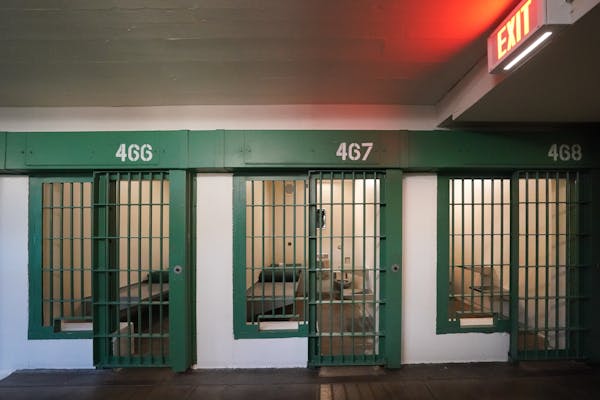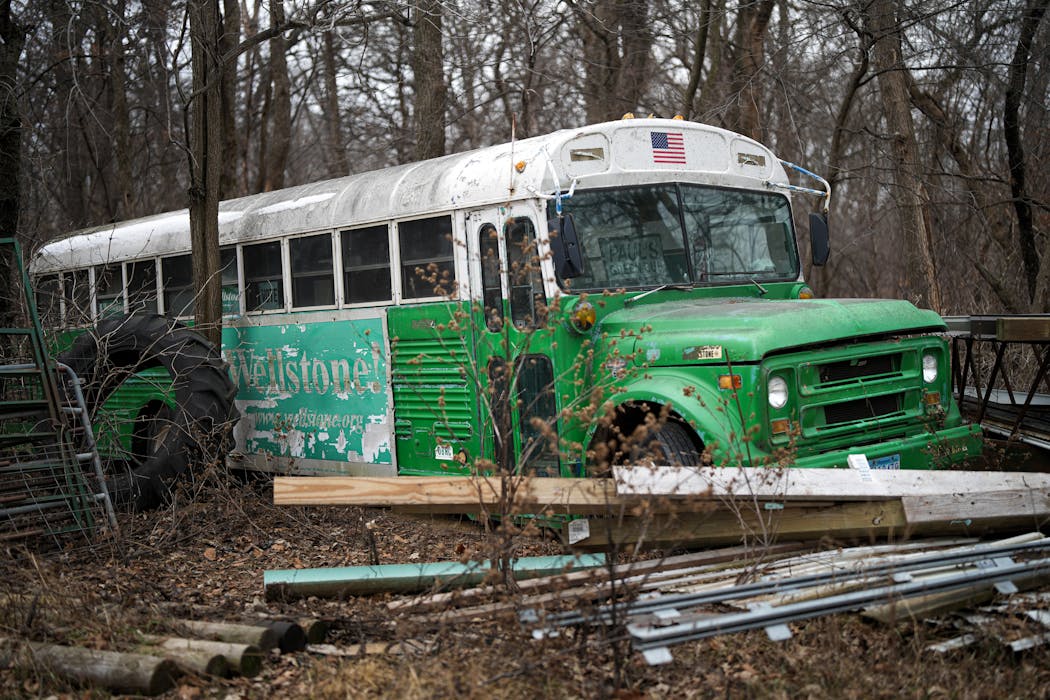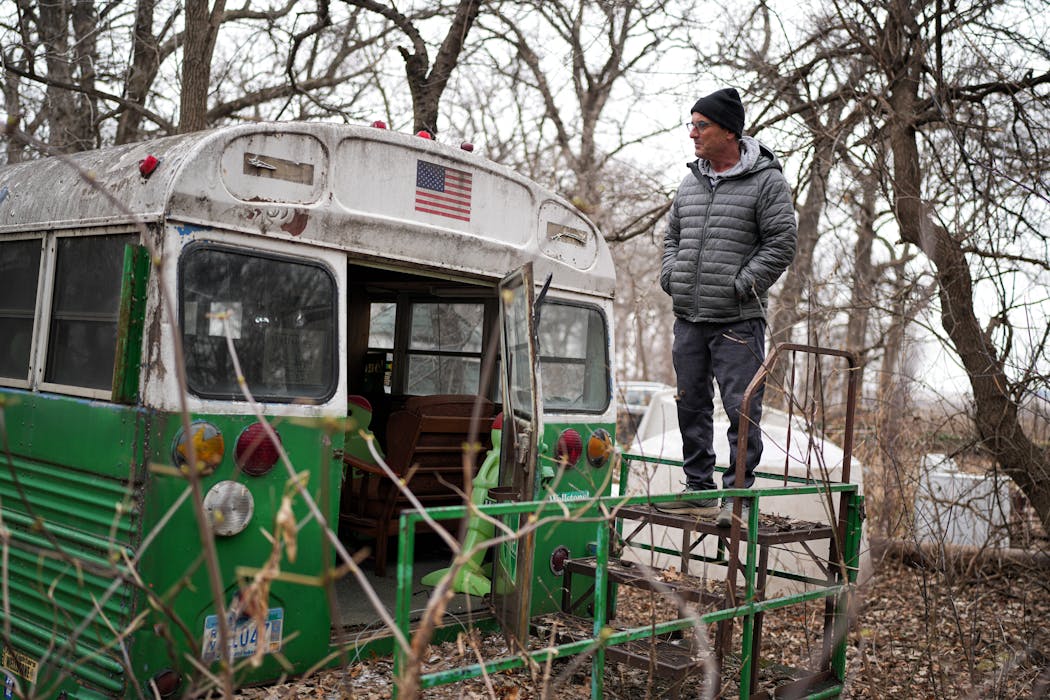What happened to Paul Wellstone's green campaign bus?
Listen and subscribe to our podcast: Apple Podcasts | Spotify
The Carleton College professor seemed to come out of nowhere in 1990, running his underdog U.S. Senate campaign out of a rickety green school bus that was prone to breaking down.
DFLer Paul Wellstone ousted Republican Sen. Rudy Boschwitz in a stunning upset later that year, turning the bus into an enduring symbol of his populist brand of politics.
Sam Woolever of Minneapolis, who grew up in a family that idolized Wellstone, wondered whatever happened to this famous vehicle. He submitted a question about it to Curious Minnesota, the Star Tribune's reader-generated reporting project.
"Wellstone was so adamant about reaching all people. Not just along party lines, [but] reaching across the aisle and listening to everyone," Woolever said. "His bus was a huge part of that."
The bus fell out of the public spotlight in the two decades since the 2002 plane crash that killed Wellstone. The Star Tribune contacted former political reporters, campaign staff and Wellstone's family to track down the bus.
We discovered that the campaign vehicle is enduring the elements in a private wooded area of southeastern Minnesota. It remains filled with artifacts from the campaign trail — a time capsule of a bygone era in Minnesota politics.
A 'distinctive style' of campaigning
In the early days of his Senate run, Wellstone's campaign was trying to come up with a way to meet voters that could also get him some much-needed publicity. An idea for a walking tour was quickly dismissed as impractical, said Dennis McGrath, a former Star Tribune reporter who was embedded with Wellstone's 1990 campaign.
Two of Wellstone's fellow professors at Carleton College came up with the concept of doing a Harry Truman-style whistle-stop tour of Minnesota off the back of a bus.
"Wellstone had taken a stand against gimmickry in campaigning, but he gave in easily on this one," McGrath and co-author Dane Smith — also a former Star Tribune reporter — wrote in their 1995 book, "Professor Wellstone Goes to Washington."
"I realized issues were not going to be enough, there had to be a distinctive style of campaigning," Wellstone said at the time.
Two campaign staffers who were lost in a suburb north of the Twin Cities stumbled on the perfect vehicle for sale on the side of the road, McGrath said. The 1968 Chevrolet school bus had already been retrofitted as a camper and included a porch off the back that would be perfect for waving to crowds and delivering short stump speeches.
The campaign bought the bus for $3,500 and had union members help paint it from baby blue to Wellstone's signature green and white. From the start, the bus frequently broke down, requiring a second car to trail it so Wellstone could get to events on time, McGrath said.
At the time, chief campaign strategist Pat Forciea feared the bus would backfire and media would "seize on a broken down bus as a symbol for a campaign that was going nowhere," Smith wrote in a 1997 Star Tribune article. To the campaign's surprise, the bus became so popular it was requested at events even when Wellstone couldn't be there.
It became a talking point, contrasting the $3,500 bus to Boschwitz's $6 million campaign war chest. And the bus was featured in Wellstone's first memorable television campaign ad.
"The bus was very much a symbol of the campaign, but it was also a reflection of the campaign and a reflection of Wellstone himself," McGrath said. "We're used to seeing candidates step off these luxury tour buses. That's standard. And this bus was anything but."
After winning the election, Wellstone rode the bus to Washington for his inauguration to the Senate (it caught on fire on the way home). It hit the campaign trail again during his successful 1996 reelection campaign. A Star Tribune article a year later said Wellstone surrendered the bus to the Greyhound Bus Museum in Hibbing, Minn., assuming at the time he wouldn't run again.
But Wellstone would pull the bus out of retirement, fixing it up when he decided to run for a third term in 2002.
The bus was still in use by the campaign when, on Oct. 25, 2002, Wellstone died in a plane crash near Eveleth, Minn., that also killed his wife, Sheila, his daughter Marcia, three campaign staffers and the plane's two pilots..
Time capsule of long-ago politics
In the immediate aftermath of the crash, the bus became a place of mourning, and then briefly part of a museum exhibit displayed in the Twin Cities and in Wellstone's hometown of Northfield, according to a 2003 article from Northfield News. It was occasionally used for parades or campaign events.
The Northfield Historical Society entered into a two-year loan agreement with the now-disbanded political organization Wellstone Action to use the bus occasionally as an outreach exhibit piece, according to the article. But the organization's board expressed concerns about the costs of maintaining the vehicle, said Sean Allen, the current executive director of the Northfield Historical Society.
With no other place for it to go, a friend of the family agreed to store the bus on his farm outside of Northfield. It spent a decade inside a barn until they ran out of space a few years ago and parked it in a grove of trees off a dirt road nearby, where it sits today.
"If it sits too much longer, it's gonna get beat up," Dave Wellstone, Paul's son, said during a recent visit to the bus, which was sitting between scraps of wood and a giant tractor tire that obscured its faded green campaign sign.
Inside the bus, underneath a thick layer of dust, almost nothing has changed.
The ties and name tag of Paul Scott, one of the bus drivers, hung near the steering wheel. Newspaper clippings from the days immediately following the plane crash were strewn across couches in the back.
Framed pictures of Wellstone, President John Kennedy and former state Senate Majority Leader Roger Moe — who was the DFL nominee for governor in 2002 — are still affixed to the walls. Campaign signs from that election are stacked in the back, ready to be delivered.
"This thing hasn't been touched. It's stayed the same," said Dave Wellstone, walking out the back doors and standing on the platform — now covered in a layer of dead leaves — where his dad used to deliver fiery campaign speeches.
He wants the bus to be cleaned up and preserved. He has had discussions about letting Northfield High School shop students attempt to repair the engine. Years ago, he helped create the Wellstone Center as a healing retreat amid the redwood trees of Northern California. He can see the bus being put to a similar use.
"Imagine it being redone with video loops of what my dad did — good work, nonpolitical, the kind of healing stuff," he said, citing his father's legacy on mental health and addiction. "People come to this healing retreat, and part of it is to see what politics used to be."
Efforts have been made to preserve Paul Wellstone's legacy, especially for a new generation of Minnesotans who know less about his work in the Senate. The federal building in Minneapolis was renamed after him last year.
Former campaign treasurer Rick Kahn said he's still amazed at the emotional connection people feel to Paul Wellstone so many years later. He thinks about what his friend, the late senator, would want done with the bus today.
"It's not a relic," he said. "It's a reminder of what is left to be done, what was unfinished that is still so important."
If you'd like to submit a Curious Minnesota question, fill out the form below:
Read more Curious Minnesota stories:
What happened to Minneapolis' famous Weatherball?
Why does Minnesota have a DFL and not just a Democratic party?
Why was the career of Minnesota's first congresswoman cut short?
Why hasn't Minnesota ever produced a U.S. president?
What happened to Minneapolis' famous 'Mighty Kimball' organ?
When's the last time a Republican won a majority in Minnesota statewide?





